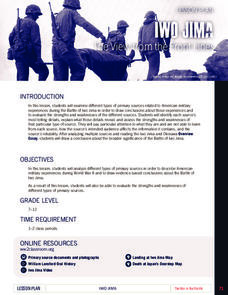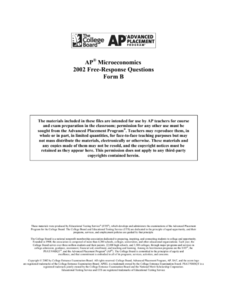National Endowment for the Humanities
The Declaration of Independence in Six Parts
Everyone knows that the Declaration of Independence is important, but what does it actually say? Members of American history classes analyze the Founding Fathers' arguments against British tyranny and for a more perfect union with a...
American Battle Monuments Commission
Honoring Service, Achievements, and Sacrifice: A WWI Virtual Field Trip
The largest offensive in United States military history comes alive in a online interactive resource. Young historians explore the Meuse Argonne battlefield and scour the landscape for evidence from the battle. They then use primary...
US National Archives
WWII: The Pacific 1939-45 – Japan and the Atom Bomb
Though the scientists who developed the atom bomb did not believe it should be used to end World War II, American President Harry S. Truman and British Prime Minister Winston Churchill were of like mind in their decision to drop the bomb...
US National Archives
WWII: The Pacific 1939-45 – Iwo Jima
Of the images that have permeated history to define American courage, perseverance, and patriotism, the 1945 photograph of United States Marines raising the flag at Iwo Jima is one of the most well known. After researching the pivotal...
US National Archives
WWII: The Pacific 1939-45 – Pearl Harbor
Though December 7th, 1941 was a day "which would live in infamy," World War II had provided many infamous days, events, battles, and atrocities in the years before. So why were American forces so surprised when Japan attacked Pearl...
US National Archives
WWII: The Atlantic 1939-45 – Battle of the Atlantic
The most dangerous line of attack during World War II wasn't the German planes soaring above Britain, but the U-Boats cutting off their supplies of food and equipment. Learners research the Battle of the Atlantic, the German campaign to...
US National Archives
WWII: Asia 1939-45 – Singapore
The fall of Singapore in World War II was shocking news for the Allied forces—but why? High schoolers explore primary source documents and videos to determine why February 15, 1942 was a wake-up call to the British Empire and its allies...
National WWII Museum
Iwo Jima: The View from the Front Lines
Iwo Jima was the site of some of the most grim fighting in World War II. Learners consider this fact while examining primary sources, including letters home, from those on the front lines. After they complete the analysis, scholars then...
National WWII Museum
The War in the Pacific by the Numbers
It may be difficult to quantify the cost of war, but an informative resource shows learners the toll of the Pacific campaign during World War II. From the number of presidents who served during the war (two) to the square feet of a...
College Board
2001 AP® Microeconomics Free-Response Questions
How does one factor in the social costs of a product? What factors influence price? Learners consider the question and others using authentic College Board materials. Other questions examine profits and competition in the market and the...
National WWII Museum
Evaluating the US Decision to Drop the Atomic Bombs
While the use of the atomic bomb was the definitive end of World War II, the terrible weapons left new questions. Young scholars use primary sources and analytical worksheets to consider the implications of the fateful decision. Then,...
National WWII Museum
Pearl Harbor: Analyzing FDR's Pearl Harbor Address
FDR's words calling the attack on Pearl Harbor a "day in infamy" have been immortalized. Learners use analysis and discussion questions to consider the origins and drafting of the famed speech that brought the United States into World...
College Board
1999 AP® Microeconomics Free-Response Questions
Imports often affect the production of domestic goods. Scholars consider the variables in this situation with a scaffolded prompt from College Board. Other items examine factors in production and compare the production advantage between...
College Board
2000 AP® Microeconomics Free-Response Questions
Monopolies may have an advantage in some markets, but what are they? A scaffolded problem set examines the effects monopolies have on a market. Other authentic College Board problems examine labor markets and how a variety of factors...
College Board
2002 AP® Microeconomics Free-Response Questions Form B
The government catches a firm in the act of polluting. What will happen to the company's profits? Learners consider the question and others using authentic College Board materials. Other problem sets examine wages and labor and price...
College Board
2002 AP® Microeconomics Free-Response Questions
Inventors with patents have a distinct advantage in the market. But what happens when the patent expires? A series of questions from College Board asks learners to consider the effects of a patent expiration. Other practice prompts...
College Board
2003 AP® Microeconomics Free-Response Questions Form B
How are monopolies and competitive firms similar and different? Scholars consider the question using authentic College Board materials. Other prompts consider supply and demand curves and the relationship between wages and output.
College Board
2003 AP® Microeconomics Free-Response Questions
A company producing smoke alarms has a monopoly. However, what factors influence its profit and production? A series of prompts from College Board asks learners to consider the impact. Other practice problems include examining what...
College Board
2004 AP® Microeconomics Free-Response Questions Form B
A company enjoys a monopoly. What happens to its profits when another firm introduces a similar product? Learners consider the case using questions from College Board. Other prompts include the effects of sales taxes and supply and...
College Board
2005 AP® Microeconomics Free-Response Questions Form B
A rabies vaccine company has a monopoly, but fluctuations in wages are impacting its profits. A series of questions from College Board considers the problem. Other practice questions include an examination of price and output curves and...
College Board
2005 AP® Microeconomics Free-Response Questions
Consumer income drives consumer demand. A set of problems explores what happens to a dairy business when consumers all of a sudden don't have as much money to spend on milk. Other prompts from College Board examine supply and demand...
US National Archives
WWII: Asia 1939-45 – Burma
Because World War II encompassed most of the globe in one way or another, many pivotal battles and events are not as visible in the history books, leaving veterans of these conflicts feeling overlooked by more famous skirmishes. High...
US National Archives
Eastern Europe 1939-45 — Stalingrad
Acts of civilian courage in Great Britain—and in one case, the island of Malta—often receive the George Cross, instituted by King George VI at the beginning of World War II. After the valiant defense of Stalingrad by its inhabitants,...
US National Archives
Eastern Europe 1939-45 — Ukraine
Was Joseph Stalin desperate or exaggerating the USSR's need for assistance on the Eastern Front in 1942? History students examine two differing opinions on Stalin's position and the reality of the Eastern Front just three years before...

























